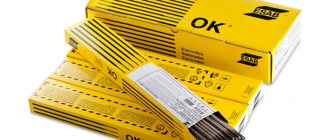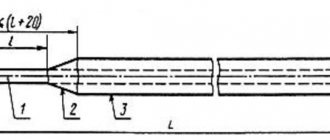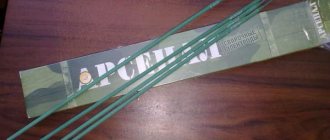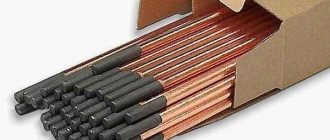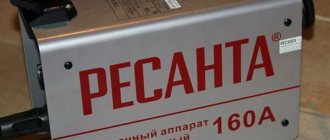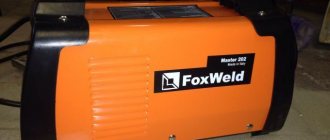Welding with MP-3S rutile electrodes is easy. Many beginners feel like experts until they switch to other brands with more complex operating parameters. MRs have their own characteristics. Welding characteristics are generally positive. The advantage is the ability to stitch over rust and connect raw parts.
Electrodes of the MP-3 brand are the main ones for welding pipelines, building and other critical structures in all weather conditions. The main purpose of electrodes with a rutile coating of grade 3C is to weld together rolled products and parts made of medium-carbon steel.
Content
- Main features of MP-3 electrodes
- Technical characteristics of electrodes
- Advantages of electrodes
- Features of welding with electrodes
- Application of electrodes for welding
- Catalog of electrodes for welding
MP-3 welding electrodes for manual arc welding are among the most popular on the modern market. The list of critical structures that they weld includes pipelines and pipe fittings, boilers and tanks, and almost the entire range of lifting and transport equipment. They are also widely used in everyday life, without causing any special difficulties in work for non-professional welders.
Designation
The letter “E” indicates that we are talking about electrodes intended for manual arc welding. The numbers “46” provide information about the value of tensile strength, which is measured in kgf/mm2. MP-3 is the brand of designated electrodes. “LUX” is a trade name assigned to its products by the manufacturer.
Next comes the cross-sectional diameter of the electrode. The letter “U” indicates that low-alloy steels with a low carbon content can be welded with these electrodes. The next letter “D” means that the electrode has a thick coating. The letter "E" refers to the designation of coated consumable electrodes, according to the international classification.
The number “43” is the value of tensile strength after the welding process is completed. “0” means that the elongation does not exceed 18 percent. (3) refers to the impact strength value of the deposited metal.
The letters “RC” stand for rutile-cellulose coating. One letter “P” will mean that the coating is purely rutile. The last two digits “11” indicate that welding with these electrodes can be carried out in all positions, excluding the movement of the electrode from top to bottom. The designation is applied to a tag glued to the packaging. This allows you to find out what characteristics the MP-3C electrode has and make the right choice.
Main features of MP-3
Electrodes for welding MP-3 are intended for joining parts mainly made of low-carbon (with a C content of up to 0.25%) and low-alloy steels. The tensile strength of such steels does not exceed 50 kgf/mm², that is, the tensile strength is 490 MPa. The rods are made from Sv-08 wire; the diameter range varies from 2 to 6 mm. The production of electrodes for welding is regulated by state standard 9466 and GOST 9467.
The products have a rutile coating (titanium dioxide), which ensures instant first and second ignition, and the weld pool is reliably protected from the harmful effects of nitrogen and oxygen. The main characteristics of the product are indicated in the labeling, for example: E46-MR-3-4-UD2, where
- E-46 – the type to which the electrode belongs;
- MP-3 – product grade (R – rutile coating);
- 4 – rod diameter;
- У – composition of the metal being welded (carbon steel);
- D2 – thick coating, second group.
The length of the MP-3 electrode depends on the diameter: with d=2...3 mm it is 350 mm, with d=4...6 mm – 450 mm. You can weld parts with a thickness from 3 to 20 mm.
Application
Welding elements of the MP-3 brand are intended for welding work at constant or variable current, guaranteeing a voltage in no-load mode of at least 50 V. In the case of supply from a direct current power source, the polarity must be reversed. During the welding process, the filler material can be held in any plane.
Technological features
- High connection quality and performance;
- Hassle-free re-ignition;
- It is easy to separate the slag crust from the weld seam;
- Minor amount of metal spatter;
- Simplicity of the process of creating a weld;
- There are no difficulties in igniting the electric arc and maintaining its stable combustion.
Under normal temperature conditions, the weld metal, as well as the deposited metal, acquire the following strength characteristics:
- The mechanical tensile strength indicator is no more than 46 kgf/mm2;
- Relative elongation - 18%;
- Impact strength - 8 kgf∙m/cm2.
To correctly calculate the operating current, it is necessary to take into account the features of using electrodes and their diameter:
- with a diameter of 6 mm only in the lower location - 300-360 A;
- 5 mm for vertical 160−200 A, for lower -180−260 A;
- 4 mm for vertical 140-180 A, for bottom 160-220 A, for ceiling 140-180 A;
- 3 mm for vertical 90-110 A, for bottom 100-140 A, for ceiling 100-120 A.
Depending on the weight, about 1.7 kg of MP-3 is consumed per 1 kg of metal for welding.
Advantages of MP-3
Welding with MP-3 electrodes with rutile coating is considered the most environmentally friendly and safe in terms of the release of toxic compounds into the air, so work can be performed in closed, poorly ventilated rooms. Among other advantages:
- good first and re-ignition;
- stable burning of the electric arc (arc – medium, short or extremely short);
- unhindered separation of slag crust;
- low percentage of spattered metal;
- the ability to weld parts of large thickness;
- high-quality, durable, intergranular corrosion-resistant seam.
Like any others, rutile-coated electrodes of the MP-3 brand must be stored in a dry room at a temperature not lower than +15 °C. The permissible moisture content in the coating is 1%. If this indicator is exceeded, the electrode requires calcination for an hour at a temperature of 150-180 °C.
general information
Welding elements of the MP-3 brand are suitable for joining workpieces made of carbon and low-carbon steels. They can be welded in close contact or leave a small gap. In the latter case, experts recommend choosing the welding mode very carefully and using less than the rated current to avoid the formation of defects or cracks in the metal.
Additive materials produced under this brand are advantageous in that during their use a minimal amount of substances is released, so there is no doubt about their safety. They are indispensable for welding carried out in particularly difficult conditions, since they are the least demanding on the cleanliness of the surface, which may have rust stains or moisture, but this does not greatly affect the quality of welding.
Welding work is carried out using conventional transformers that maintain a minimum voltage of 50 V. MP-3 welding material can also be used for mounting parts of medium or large thickness. The metal can be easily welded throughout the entire recess, ensuring high strength of the joint created. Based on the technological conditions of welding work, when working with these electrodes, it is not necessary to create a large arc to obtain a temperature sufficient to set the metal with the electrode .
As part of the preparatory stage, the electrodes must be dried and calcined, which only has a positive effect on their working properties. Electrodes of this brand can be used in combination with transformers that support operation with direct and alternating current. Filler material can be worked in any position due to the fact that, regardless of the operating conditions, they can provide a high quality connection.
At the end of welding, it is necessary to perform the final operation - remove slag from the metal. This is done very easily, so the quality of the connection remains consistently high. The coating of the electrode directly affects its inherent advantages. The welding material has a special chemical composition, thanks to which it is possible to maintain a stable arc when working in any plane. Due to the stability of the arc, the quality of welding is consistently high, regardless of the influence of extraneous factors.
Features of MP-3 welding
Parts can be welded using either alternating or direct current of reverse polarity. When using a transformer, the open circuit voltage must be 65 (+/-5) Volts. Welding is possible with both long and short seams.
To perform RDS, any spatial positions are acceptable except for vertical descent.
- Standard bottom (horizontal) position. Parts of large and medium thickness are welded in this way. The diameter of the MP-3 electrode is, as a rule, at least 6 mm. The rod is positioned at an acute angle to the seam plane in the direction of welding. Cook on a medium and short arc at high currents.
- Welding “in a boat” - fillet welds are welded in the lower position (angles 30 °, 45 °, 60 °), welding is performed on the shortest possible arc with a vertically located rod. With a “symmetrical boat” (the electrode conditionally divides the right angle of the connection into two 45% each), they usually cook at higher currents. “Asymmetrical boat” implies that the rod divides the angle into 60° and 30°; in this case, sagging and undercutting of the weld are more likely.
An electrode of this brand is also used to weld a horizontal seam on a vertical plane, a vertical seam in an upward position, and a seam in a ceiling position.
Let us note once again that the rod must be at an acute angle to the surface, since a different position may result in increased release of slag and its entry into the weld pool.
Peculiarities
The filler material of this brand can be used to connect structures both long and using short tacks. With their help, it is possible to perform metal connections without preliminary preparation, which may have:
- wet surface;
- traces of oxides and contaminants;
- signs of rust.
Welding elements MP-3 are also suitable for connecting elements along gaps, but when using a minimum current. Otherwise, pores may appear in the seam. The presence of the letter “m” (MR-3m) in the marking of welding elements indicates the presence of a rutile-ilmenite coating, and the letter “c” (MR-3s) indicates the use by the manufacturer of a rutile coating containing special ionizing additives.
If we compare these two types of electrodes in terms of characteristics, then these are the same MP-3 electrodes.
The MP-3 welding material simplifies the arc ignition process due to the presence of special additives in the coating when using low-power welding machines with a voltage of about 50 V. In addition, they are more preferable than conventional MP-3 electrodes due to higher sanitary and hygienic indicators . Welding carried out using such elements is accompanied by the release of no more than 0.6 g of manganese. When using conventional MP-3 electrodes, 1.25 g of the substance is released.
In addition, MP-3 elements allow for more uniform seams, which has a positive effect on the mechanical characteristics of the joint.
Application of MP-3 electrodes
Electrodes make it possible to weld parts of mechanisms and structures of a wide range of equipment.
- Mills of various types (sheet rolling, section rolling, crimping, etc.).
- Cranes, elevators, conveyors, escalators, winches and other lifting and transport equipment.
- Gas, oil pipelines, oil storage tanks.
- Containers, tanks for transportation of dangerous goods.
- Steam boilers and other boiler equipment.
Electrodes are also used to weld metal building structures, including reinforcement and other embedded elements for reinforced concrete products.
Advantages
LEZ MR-3S electrodes have characteristics due to which they have undoubted advantages:
- The resulting connection is highly durable.
- Ignition of the arc is easy, as is its re-ignition.
- The arc can be short or medium length.
- The seam formed is smooth and has a good appearance.
- There are no clearly defined transition zones between the surfacing and the base metal.
- The rutile coating protects the seam from slag getting into it and the formation of oxidation on the surface.
- Spattering of metal during welding is insignificant.
- Easy separation of slag crust.
- It is possible to connect parts of considerable thickness.
- Connecting wet surfaces and those with traces of corrosion.
- No release of harmful substances during combustion of the coating.
- The seam is resistant to corrosion.
- The welding process is highly productive.
- Electrodes can be used to make not only long seams, but also short tacks.
These advantages are the reason for the widespread use of electrodes of this brand.
Decoding the abbreviation, what the symbols in the marking mean
The label provides information about technical characteristics in a concise form. So, for example, certain electrodes of the MP-3 brand have the following designation - “E46 - MP-3 LEZ - 4 - US / E432 (3) - P21.” The above letters and numbers include the following contents:
- E46 - indicates the type of electrode, specifically in this case for welding low-carbon and carbon steels (with a carbon content of up to 0.25%) with a tensile strength of no more than 46 kgf/sq. mm;
- MR-3 LEZ - denotes the brand of electrode and its manufacturer, in this case MR-3, manufactured at the Losinoostrovsky Electrode Plant;
- 4 – indicates the diameter of the welding wire of the electrode, here 4 mm;
- U - indicates what materials the electrode is intended for welding, in this case for carbon and low-carbon steels;
- C - indicates the thickness of the coating, here C is the average thickness (there are also thin, thick and extra thick, which are marked M, D, G, respectively);
- E - indicates the relationship to the type of melting with coating;
- 43 – these numbers indicate tensile strength, namely 430 MPa;
- 2 – characteristic of relative elongation, in this case in the region of 24% or more;
- (3) – determines the minimum temperature at which the impact strength is not lower than 34 J/sq. cm, in a particular case, the number 3 corresponds to a temperature of -20°C;
- P – denotes the type of coating, here – rutile;
- 2 – the number indicates the spatial positions in which welding can be performed efficiently, in this case – in all except “top-down” in a vertical position;
- 1 – You can weld with both direct and alternating current.
What are they intended for, areas of application, for welding what steels
The material of welding wire Sv-08 MR electrodes with low carbon content limits the use of this filler material for manual arc welding of steels with a carbon content of no more than 0.25%. The mechanical characteristics of which, namely, the tensile strength of the structures being welded, should not exceed 46 kgf/sq. mm. Only such steels will have a high-quality weld when using MR grade electrodes.
The wide applicability of low-carbon and carbon steels in various fields of industry and construction contributes to the widespread use of MP grade electrodes . Their high arc stability and easy re-ignition make them popular among welding beginners. Professionals guarantee high-quality welds on critical structures and often use MR electrodes for tack welding followed by the use of electrodes with a basic coating.
Recommended current values
The operating current depends on the diameter of the selected electrode and the welding position. Recommendations for selection are summarized in a table, current strength is given in amperes
| Diameter, mm | Vertical seam, amperage | Lower position, current strength | Ceiling position, current strength |
| 3 | 90-110 | 100-140 | 100-120 |
| 4 | 140-180 | 160-220 | 140-180 |
| 5 | 150-200 | 180-260 | Not applicable |
| 6 | Not applicable | 300-360 | Not applicable |
It is important to remember that these are indicative values. For specific parts, a test weld is made, and the current intensity is adjusted depending on its results . You should start with the minimum values, since rutile electrodes do not like excessive current values.
If the test seam shows insufficient penetration, the current should be gradually increased in 5 ampere steps until satisfactory results are obtained. At elevated operating current values, the spattering of the metal increases and the stability of the arc decreases. Burn-throughs may occur on thin workpieces.
What is the difference, what is the difference between MR and ANO, USENI, OZS, OK
Electrodes of brands MR, ANO, OZS and have a rutile coating. This determines their similarity in the features of welding technology . However, some specific modifications for specific welding jobs may have minor differences from other brands of rutile-coated electrodes.
Electrode MR-3S
The UONI brand of electrodes has a basic coating, which makes the difference with MR brand electrodes very significant :
- the properties of rutile coating differ in their effect on the welding process from the main coating;
- unlike MR, which are used both on direct current and alternating current, UONI brand electrodes can only be welded on direct current of reverse polarity;
- MR requires much less preparation of the surface of the materials being welded than SSSI;
- SSSI is many times more sensitive to moisture than MR.
Which ones are better for the inverter and in other situations
The electrode brand does not play a decisive role in choosing an inverter or other welding equipment. It is important that the characteristics of the additive match the capabilities of the device. The main thing is to choose the right filler material for the materials being welded.



